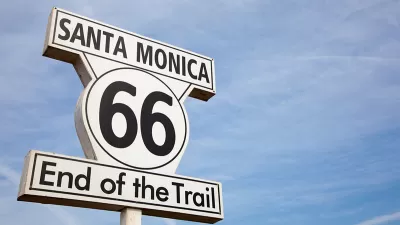Frustrated by what's passing as "smart growth" and "transit oriented development," Bill Adams postulates ten refinements (or less subtly stated clarifications) of the principles of smart growth and new urbanism.
"These days, a lot of projects are crashing through the gates of community plans and dashing existing neighborhood character under the banners of smart growth or transit oriented development. Typically, such projects are simply high density or near transit corridors, or sometimes they include gratuitous green space and walking paths. However, they fail in many of the finer points of smart growth, new urbanism, or transit oriented development."
Therefore, San Diego land use attorney Bill Adams offers 10 clarifications and extrapolations of existing smart growth and new urbanism principles, as follows:
- Purge the term NIMBY from your language and your thinking. It stultifies any further understanding of community concerns, or how to reach a compromise.
- Respect community planning.
- Integrate with the surrounding community.
- In transit oriented developments (TODs), transit orientation should exceed auto orientation.
- Respect neighborhood character & identity.
- Increase density incrementally.
- Conform to existing “smart” retail corridors and centers.
- Look for opportunities to narrow (verb) streets and vanquish parking lots.
- Prioritize non-auto transportation by creating unique or exclusive pedestrian and bicycle amenities.
- Design for human nature rather than efficiencies and logic.
FULL STORY: 10 Rules for Smarter Smart Growth

Planetizen Federal Action Tracker
A weekly monitor of how Trump’s orders and actions are impacting planners and planning in America.

Map: Where Senate Republicans Want to Sell Your Public Lands
For public land advocates, the Senate Republicans’ proposal to sell millions of acres of public land in the West is “the biggest fight of their careers.”

Restaurant Patios Were a Pandemic Win — Why Were They so Hard to Keep?
Social distancing requirements and changes in travel patterns prompted cities to pilot new uses for street and sidewalk space. Then it got complicated.

Platform Pilsner: Vancouver Transit Agency Releases... a Beer?
TransLink will receive a portion of every sale of the four-pack.

Toronto Weighs Cheaper Transit, Parking Hikes for Major Events
Special event rates would take effect during large festivals, sports games and concerts to ‘discourage driving, manage congestion and free up space for transit.”

Berlin to Consider Car-Free Zone Larger Than Manhattan
The area bound by the 22-mile Ringbahn would still allow 12 uses of a private automobile per year per person, and several other exemptions.
Urban Design for Planners 1: Software Tools
This six-course series explores essential urban design concepts using open source software and equips planners with the tools they need to participate fully in the urban design process.
Planning for Universal Design
Learn the tools for implementing Universal Design in planning regulations.
Heyer Gruel & Associates PA
JM Goldson LLC
Custer County Colorado
City of Camden Redevelopment Agency
City of Astoria
Transportation Research & Education Center (TREC) at Portland State University
Camden Redevelopment Agency
City of Claremont
Municipality of Princeton (NJ)



























